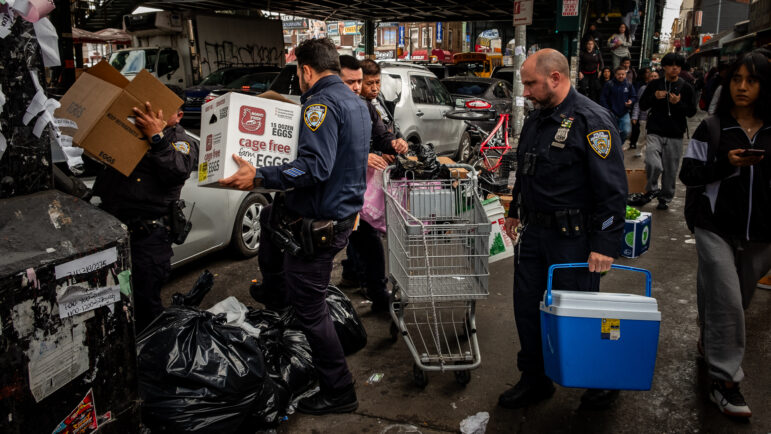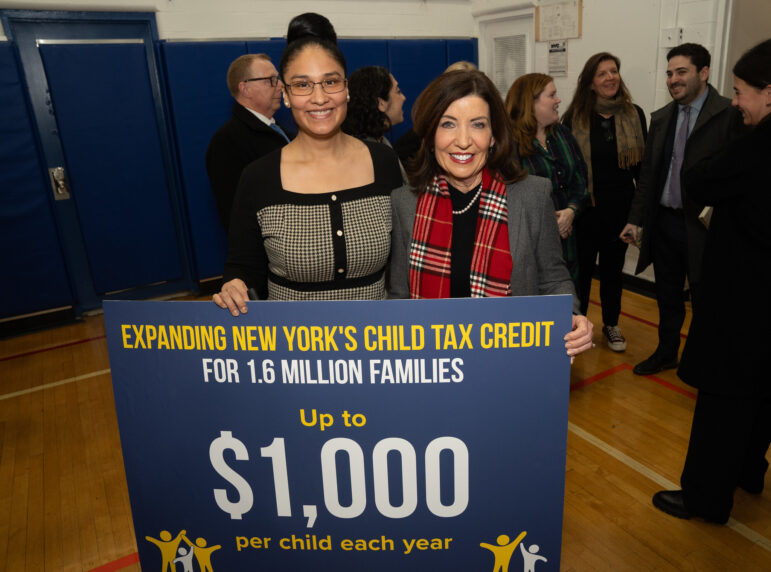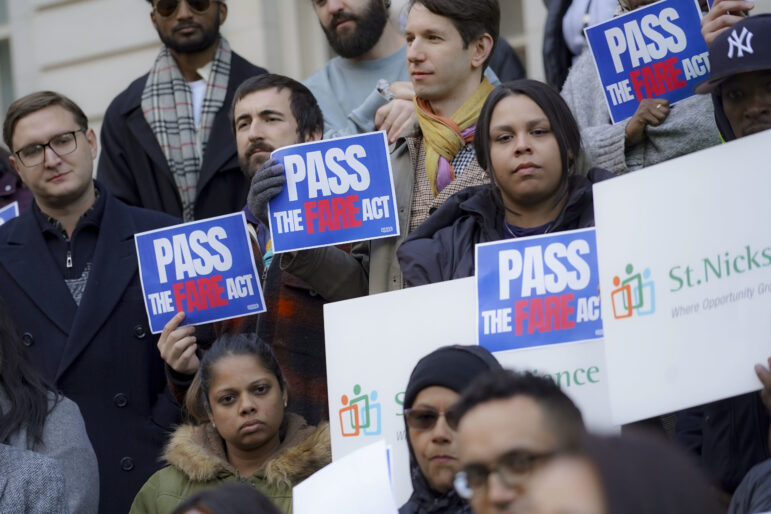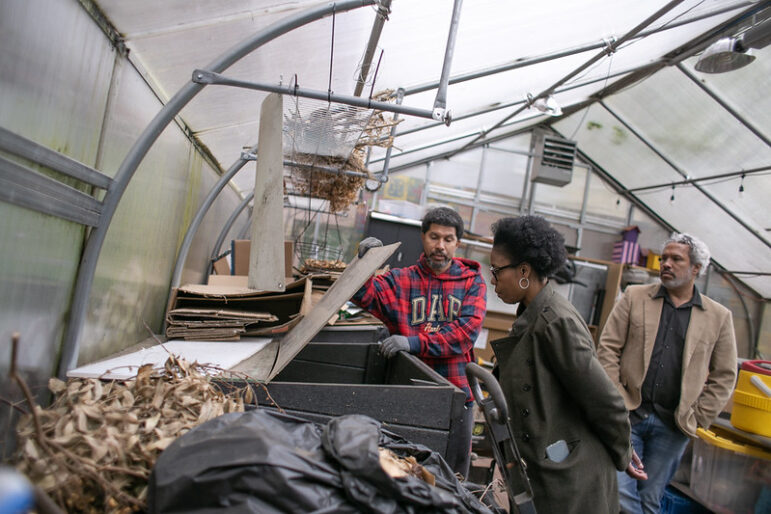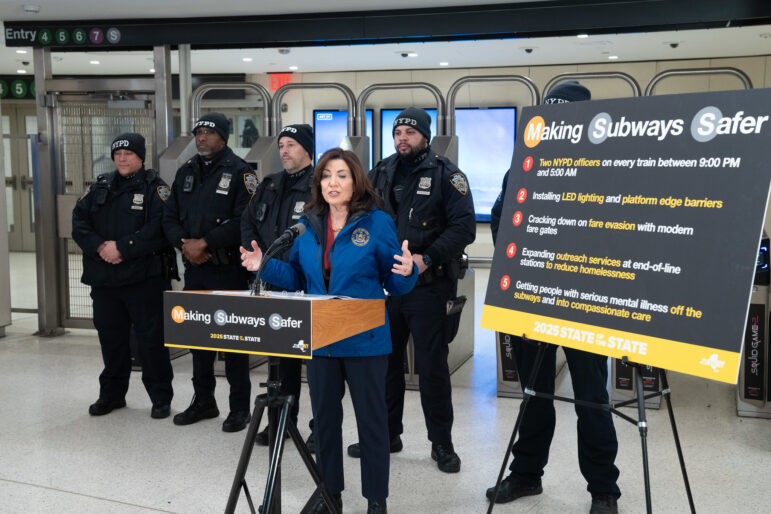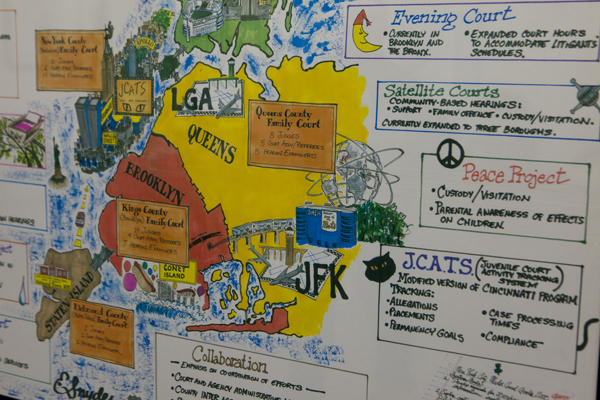
Photo by: Marc Fader
A poster in chief Family Court Judge Edwina Richardson-Mendelson’s office diagrams the web of services the court coordinates for troubled families.
In 1994, New York State chief judge Judith Kaye announced plans to revamp Family Court. Kaye championed court reforms, like setting strict timelines for cases in order to speed resolution. Noting that three in four people charged with child abuse also abused drugs or alcohol, she created Family Drug Treatment Courts in 1997, to direct substance abusers to programs and treatment rather than jail, keeping families intact (with support) rather than sending parents to prison and kids into the foster care system.
She extended Family Court hours to include evening sessions, on the basis of rising projections of cases. Under Kaye’s leadership, judges began to specialize in distinct areas of Family Court practice. Proceedings, until then sequestered from view, were opened to the public.
Because creating judgeships would have required changing state law, Kaye instead created the position of judicial referees to hear cases of custody and visitation. She additionally oversaw the creation of community courts, in neighborhoods as disparate as Red Hook and Harlem, to monitor compliance with drug treatment and mental health plans, for example, and to centralize access in underserved communities to a spectrum of legal and social services.
Another major improvement in the past decade concerns children whisked into emergency foster care before a petition can be heard in Family Court: Prior to 2005, ACS routinely removed children from the homes of women who were victims of domestic violence, basing its actions on the theory that children could be at imminent risk. A class action lawsuit, Nicholson v. Scoppetta, challenged this practice. Ultimately, a ruling by Kaye forced a serious discussion of what actually constitutes neglect and established the need for a court order before a child can be removed from the home.
In practice, this means that ACS must request a child’s removal in Family Court. Parents who are present in the court have a voice in those proceedings; they can challenge the removal and request the return of their children within three days of their removal.
This reform led to steep declines in the practice of simply removing kids at will, without official approval. It also gives families a chance at mediation, via the family team conference, before a case goes before the judge.
Another major advance concerns juvenile justice: Knitting together youth justice cases with those that concern abuse, neglect and a child’s broader well-being affords more humane treatment for New York City’s youth. Recent initiatives to bring youths in juvenile justice facilities closer to their home communities and innovative hybrid court models marry the practice and philosophy of Family Court with the statutory responsibilities of New York State criminal court.
The Staffing Stalemate
Eighteen years later, Kaye’s reform agenda clearly has had an effect. The referees, for instance, play an essential role in keeping Family Court from drowning in its caseload. Other changes didn’t live up to their billing. Her efforts to speed up court proceedings show little impact in today’s courtrooms. Evening hours became too expensive in the post-2008 fiscal atmosphere and were scrapped. And some reform ideas—like having different judges specialize in different aspects of family law—had unintended consequences.
“The law wasn’t as complicated before people specialized. It’s apples and oranges,” says Richardson-Mendelson, current head of the Family Courts. “The law has changed dramatically, and the obligations of the court have changed tremendously as well.”
Much of the persistence of Family Court’s problems can be chalked up to the issue that Kaye tried to navigate around: judicial staffing. But the statutory limit is only one part of the problem. Judgeships to which the system is, right now, entitled have disappeared.
Of 11 judges legally assigned to Manhattan Family Court, only eight now sit on the bench, a court attorney there says. Of 47 Family Court judgeships citywide, eight vacancies will exist in 2012—and it’s only April. No additional magistrates may be appointed to pick up the slack, because their ranks, too, are mandated by state law.
“We’ve lost staff over the past two or three years, to retirement incentives and layoffs,” the court attorney says, citing economic pressures and cuts from Albany. “We have lost staff as cases have increased.”
Mark Bloustein, of the Office of Court Administration in Albany, says new judgeships are “not likely to happen anytime in the future,” citing a cost of “approximately $1 million a part,” or total spending of close to $40 million for new Family Court judgeships statewide. “There have been no new judgeships since 1991 in New York City,” Bloustein says, and adds that getting any new jurists appointed will be “a major political lift, even though it’s apparent that the caseload is increasing, especially in New York City.”
Bloustein says staffing problems extend across all state court systems, not just Family Court. In Supreme Court, for example, judges are elected to the bench. But half of state Supreme Court justices are appointed as acting justices and have not been elected. “We have robbed civil court” benches to staff other courtrooms, including Family Court, Bloustein says.
Chief Judge Lippman continues to support the idea of new judgeships, Bloustein says, but resources are determined “by the governor and the legislature.” He adds, “Last year, we had to lay off 400 people. We’ve been able to keep courts open, but there’s no night court, and the judicial hearing officer program has basically been scrapped. At the end of the day, it’s what the legislature and the governor give us.” Bills offered in the Legislature and in the City Council to increase Family Court judgeships have consistently fizzled.
Lawyers and advocates say that Ronald Richter, the new head of ACS, brings a unique blend of skills and experience to the job. He has represented children as Legal Aid lawyer, served as a Family Court judge and worked at City Hall. A looming question, though, is whether he will remain at the head of the agency when a new mayor is elected. (The backstairs betting is lively: Some court watchers say he will return to the bench; others say that Richter’s now in a position to advance his career into the stratosphere. There’s little position in New York City more powerful than having done a big favor for the mayor. Richter consented to an interview after this issue had already gone to press.)
The big fix
Is there a different remedy for the rising tsunami of Family Court filings, the long waits, the depersonalization and numbness of Family Court? What will address the challenge of cases that extend for years, through the lives of the youngsters they concern? Will the court ever have enough judges, time, money and support to function smoothly and efficiently? Is there a cure, after a half-century of cases, for the exhaustion and underfunding—the institutional shortchanging of this crucial court of the poor?
City Limits asked people intimate with the workings of the court—lawyers, advocates, court attorneys, clerks, judges and parents—what they would do to fix the court if human and economic resources were ample.
A Legal Aid attorney says we must “get advocates and social workers working as allies with kids and families.” She adds, “ACS is seen as the Enemy for removing kids. There needs to be more support for families and less demonization.”
“In custody hearings, they don’t want to hear about support. In support hearings, they’re not interested in custody,” says one parent. “My case is three years old. We have been before so many judges, I can’t keep track. Every time, I go in with the whole history of the case. I’m living it. But all the judges know is the microcosm, the issue of the moment. That’s all they care about. There’s no memory, no cumulative history. Why don’t judges have access to the whole case history?”
An 18-B attorney—a private lawyer who is part of a pool of counselors from which legal help for the indigent is drawn—says there’s no way to get around the complexity of Family Court’s role without more resources. “Family Court dysfunction arises from people’s lives: births, deaths, separations, arrests, incarcerations,” he says. “There have to be more judges and more resources to deal with the realities of people’s lives, which don’t conform to court calendars or bureaucratic structures.”
A judge, however, says what the system needs is more lawyers: “Expand the right to counsel, so people have competent professional representation. Now the right to counsel is limited to the truly indigent. Otherwise, you have to hire an attorney, which most people can’t afford. I couldn’t hire an attorney without going into debt, and I’m a judge!”
Another parent proposes a narrow fix: “Limit the number of petitions that people can file. My ex-husband is very smart. He manipulated the court and paperwork to keep my children in foster care.”
One advocate believes the mind-set is what needs changing. “What is fundamentally needed is a shift around children—around how we think about the children who are part of the court system,” he says. “A teenager in trouble has lived through more in 14 years than most judges and lawyers. They are resilient. They may care for younger siblings or a disabled parent. We need to shift from a deficit-based model to a strength-based model. A child is not only the worst thing they have ever done.” One former Family Court lawyer agrees: “The culture of Family Court must change. Every single person in Family Court is in pain. The cost of a punitive approach is more crime, a well as harm to children.”
What challenges both critics and optimists is the size of the problem Family Court is tasked with solving, or at least managing.
Richardson-Mendelson has worked as a lawyer and judge in the city’s Family Courts for nearly a quarter-century. She acknowledges Family Court workings are sometimes hobbled by the very ideals that define the court.
“I desperately want to make the experience for people who appear [in Family Court] the best experience a court can provide, but the issues that people are experiencing are really deeper than a court can address,” she says. “Family Court as a court of law can do its job better. But at the base of many of our most difficult cases is poverty—and Family Court can’t fix poverty.”
This is the final chapter in our report. To see charts, read sidebars and watch related video, click here


